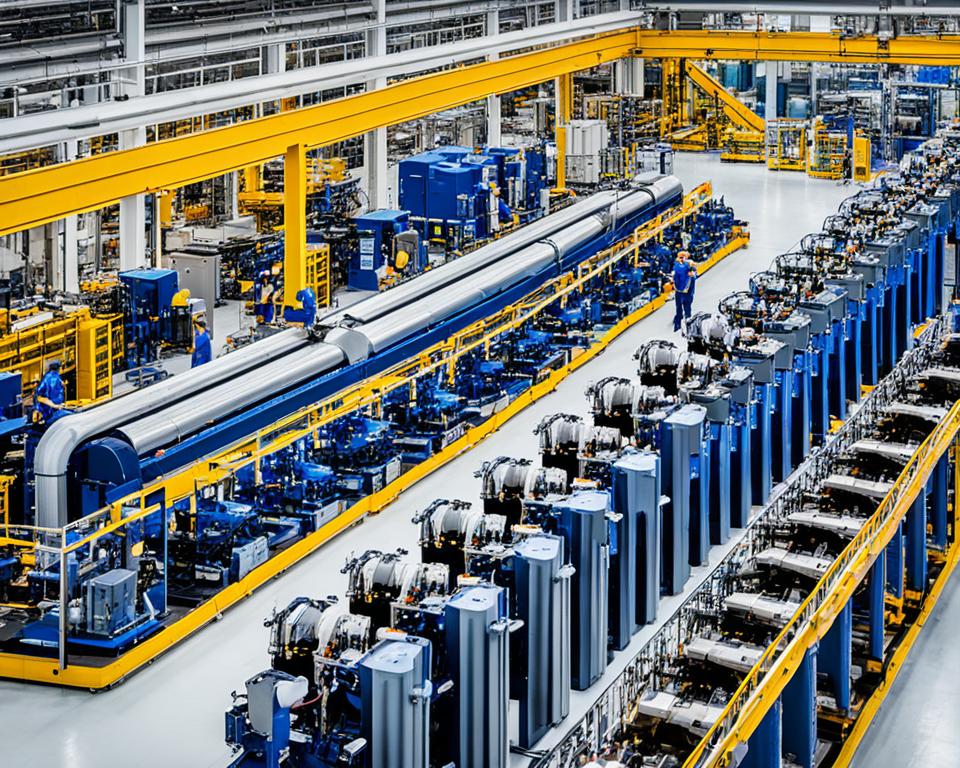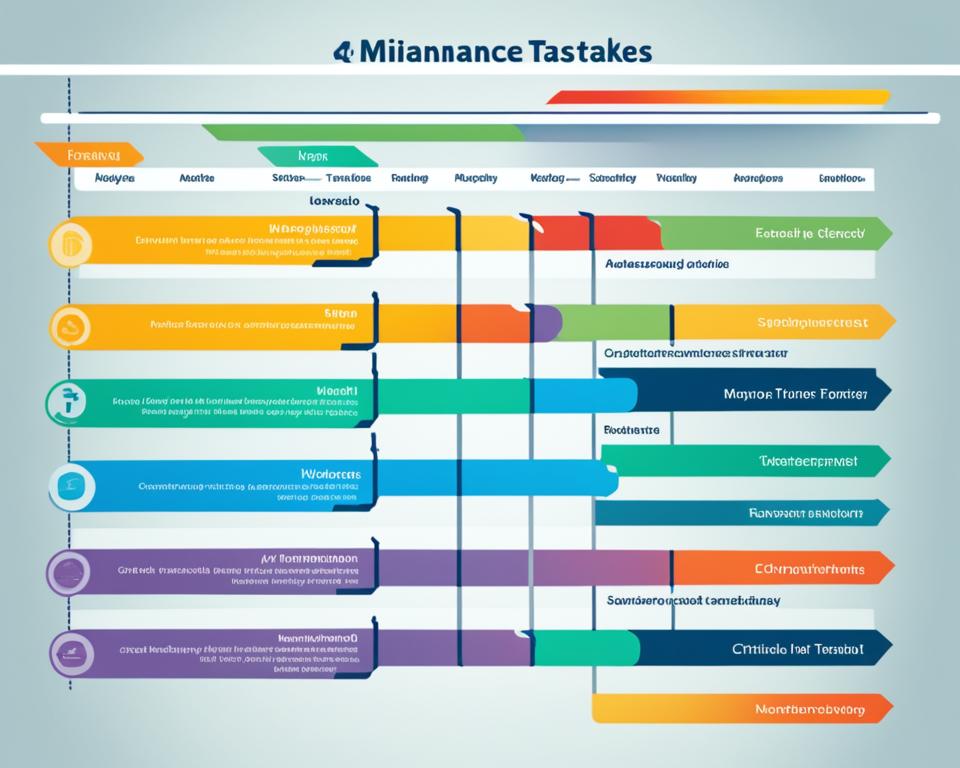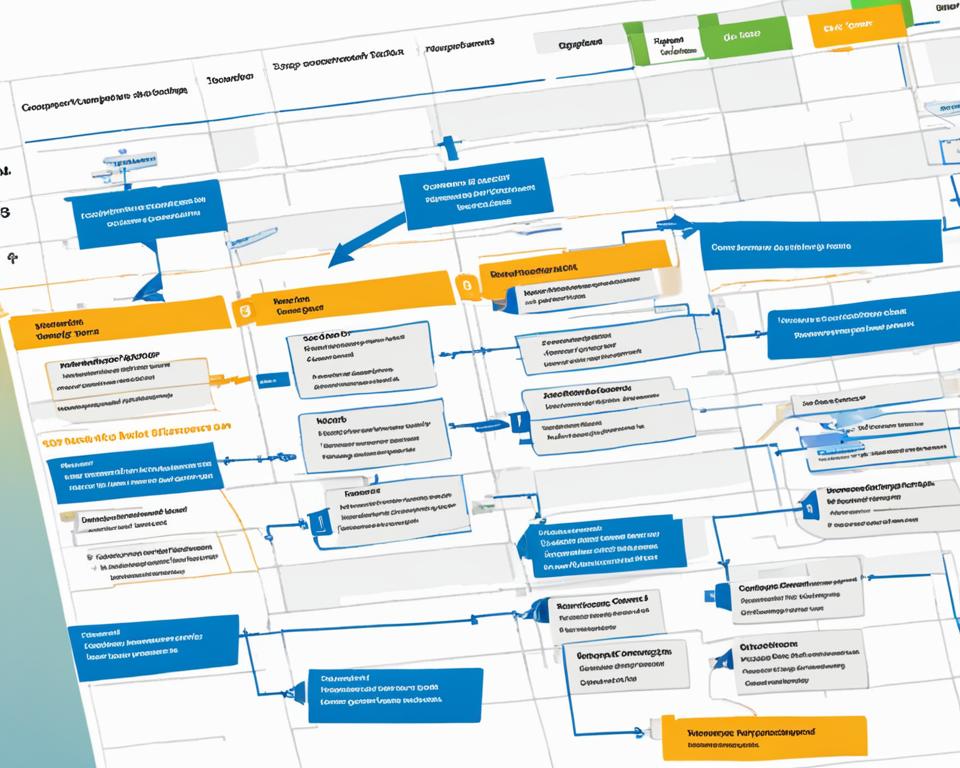Ever wondered how top companies keep their equipment running smoothly and avoid downtime? In this article, we’ll look at how SAP PM changes the game in plant maintenance. We’ll see how it boosts maintenance processes and improves asset management. By exploring SAP PM, we’ll learn key strategies for keeping maintenance ahead of the game.
These strategies include preventive maintenance, condition monitoring, and inventory management. They’re vital for anyone wanting to boost productivity in plant maintenance.
Key Takeaways
- SAP PM is essential for enhancing plant maintenance efficiency.
- Effective asset management leads to improved equipment reliability.
- Preventive maintenance strategies can significantly reduce downtime.
- Condition monitoring plays a key role in proactive maintenance approaches.
- Integrating SAP PM with existing systems offers comprehensive management solutions.
Introduction to Plant Maintenance
Plant maintenance is key to keeping manufacturing and processing smooth. It helps improve how things run and cuts down on unexpected stops. It’s important to know about different maintenance ways like reactive, preventive, and predictive maintenance.
Reactive maintenance fixes problems as they happen, which can be costly. Preventive maintenance does regular checks to stop equipment from breaking down. Predictive maintenance uses data to predict when maintenance is needed, keeping things running well and lasting longer. Each method has its own strengths, but they work best together with a good plan.
It’s vital to make the most of these maintenance strategies for safety and efficiency. A good maintenance plan brings many benefits, such as:
- Less equipment downtime
- Lower costs
- Better safety
- Longer machine life
Mixing different maintenance strategies can make a plant stronger. By always improving these plans, companies can meet their maintenance goals and boost productivity.
| Maintenance Strategy | Description | Benefits |
|---|---|---|
| Reactive Maintenance | Fixing issues as they arise | Increased downtime, higher costs |
| Preventive Maintenance | Scheduled maintenance activities | Promotes reliability, lowers failure rates |
| Predictive Maintenance | Data-driven forecasts of when maintenance is needed | Optimized resource use, reduced unscheduled downtime |
What is SAP PM?
SAP Plant Maintenance (PM) is key for companies wanting to make their maintenance smoother. It’s a software that helps manage maintenance work better. It makes maintenance tasks easier, boosts work efficiency, and makes assets more reliable. SAP PM combines many tools to help manage equipment and maintenance tasks well.
Overview of SAP PM Features
Some top SAP PM features include:
- Work Order Management: Plan, do, and check maintenance tasks well.
- Equipment Tracking: Keep track of equipment performance and problems.
- Preventive Maintenance Scheduling: Set up maintenance plans based on how often things are used.
- Reporting and Analytics: Get useful insights from real-time data.
These features help create a strong plan for managing maintenance. This makes sure equipment works its best.
Benefits of Implementing SAP PM
Using SAP PM brings many benefits of SAP PM that help businesses do better:
- Increased Efficiency: Faster processes mean less downtime and lower labor costs.
- Cost Savings: Regular maintenance means less need to replace equipment, saving money.
- Enhanced Decision-Making: Easy access to data helps make better choices about what to fix first.
Companies using this software can handle maintenance better. This leads to more work getting done and more profit.

Importance of Preventive Maintenance
Preventive maintenance is key to keeping equipment reliable and efficient. It helps avoid sudden failures, which can be very costly. I’ll share important strategies for a good preventive maintenance plan.
Key Strategies for Preventive Maintenance
Here are some key strategies for better preventive maintenance:
- Routine Inspections: Regular checks spot problems early.
- Scheduled Servicing: Regular servicing keeps equipment running longer and better.
- Documentation: Keeping maintenance records helps track trends and equipment health.
- Employee Training: Well-trained staff make operations more efficient.
How SAP PM Supports Preventive Maintenance
SAP PM support has tools that make preventive maintenance easier. The software helps with planning and scheduling. It also makes tracking and reporting easier.
- Automate maintenance schedules by time, usage, or condition.
- Generate reports on performance or maintenance history.
- Help teams work together better for maintenance tasks.
Using SAP PM support helps organizations keep their operations running well and efficiently.
Understanding Asset Management
Asset management is key to making plant maintenance smoother and more efficient. It helps make the most of equipment’s life and keeps productivity up. By looking at asset management in plant maintenance, we see how it helps with big decisions and using resources well.
Role of Asset Management in Plant Maintenance
Asset management does more than just track equipment. It uses data to make smart choices that cut downtime and costs. This approach leads to fixing problems before they start and makes maintenance fit with business goals. It makes sure resources are used where they’re needed most.
Utilizing SAP PM for Effective Asset Management
Using SAP PM for asset management makes maintenance better. This tool gives deep insights into how assets are doing and their maintenance history. It helps plan and do maintenance tasks better.
With SAP PM, companies can keep an eye on asset conditions in real-time. They can spot problems early and plan maintenance better. This way, they avoid risks, make equipment last longer, and support a sustainable maintenance plan.

Maintenance Planning Basics
Effective maintenance planning is key for a plant’s smooth operation. It needs a systematic approach to match maintenance needs with resources. By knowing the steps, I can make better decisions for efficiency. SAP PM planning tools help manage maintenance tasks well, making planning easier.
Steps in Effective Maintenance Planning
To plan maintenance well, I follow these steps:
- Forecasting Maintenance Needs: Spotting issues early is crucial. Historical data helps me predict when maintenance is needed.
- Resource Allocation: The right people and materials are key at the right time.
- Scheduling: A clear schedule keeps maintenance on track and efficient.
- Monitoring: Tracking maintenance lets me see how well it’s working and adjust as needed.
Using SAP PM for Enhanced Planning
SAP PM brings advanced tools to maintenance planning. These tools help combine the steps for better management. With SAP PM, forecasting, scheduling, and resource planning are easier. Data insights improve maintenance planning by showing asset health clearly. For more on SAP and customization, check out this article.
Strategies for Maintenance Scheduling
Effective maintenance scheduling is key to keeping equipment running well. By using smart maintenance plans, companies can cut down on equipment downtime. This also helps use resources better. Methods like Gantt charts and Just-In-Time (JIT) can make maintenance scheduling better.
Gantt charts show maintenance tasks over time. This helps teams plan and use resources well. It also makes it easier for team members to keep track of progress and spot any issues. JIT focuses on maintenance at the right time, cutting down on idle time and boosting efficiency.
SAP PM makes it easier to plan and carry out maintenance schedules. It helps my team work better together, making sure all tasks are done on time. Good scheduling makes operations smoother and helps equipment work reliably, leading to more productivity.

Maximizing Equipment Reliability
Keeping equipment reliable is key to smooth operations and avoiding sudden downtime. By using various methods to boost reliability, I can make crucial machines work better. Predictive maintenance, detailed checks, and reviewing performance are great ways to keep equipment running well.
Techniques for Improving Equipment Reliability
There are many ways to make equipment more reliable, such as:
- Predictive Maintenance: Using data to foresee equipment failures early.
- Regular Inspections: Scheduling reviews to fix issues fast.
- Employee Training: Making sure everyone knows how to use and maintain equipment.
- Root Cause Analysis: Finding out why equipment fails to stop it from happening again.
Utilizing SAP PM to Enhance Reliability
SAP PM has tools that help a lot with keeping equipment reliable. It lets me watch equipment conditions closely and act early to prevent problems. SAP PM’s main features for reliability are:
| Feature | Benefit |
|---|---|
| Real-Time Monitoring | Allows for quick actions with precise data. |
| Automated Alerts | Notifies staff about maintenance needs, cutting down on unplanned downtime. |
| Reporting Tools | Helps analyze equipment performance over time. |
| Scheduled Maintenance Planning | Makes maintenance smoother by following equipment usage patterns. |
Condition Monitoring in Plant Maintenance
Effective maintenance strategies use condition monitoring a lot. This method checks the health of equipment in real-time. It helps make maintenance decisions ahead of time. This way, it prevents failures and makes equipment last longer.
The Role of Condition Monitoring
Condition monitoring is key in maintenance management. It keeps track of how equipment is doing. This lets organizations spot problems early. Then, they can fix things before they break down, cutting down on unexpected stops and expensive fixes.
Here are the main benefits of using condition monitoring:
- Enhanced Safety: It predicts when equipment might fail, lowering the chance of accidents.
- Cost Savings: It focuses maintenance efforts, cutting down on unnecessary work and costs.
- Increased Efficiency: It helps optimize how things work and how resources are used.
Incorporating Condition Monitoring in SAP PM
Adding condition monitoring to SAP PM is key to getting the most out of it. SAP PM uses advanced analytics and reporting. This lets organizations get useful insights from their data. This leads to:
- Data Analysis: SAP PM uses past and current data for a deep look at how equipment is performing.
- Automated Alerts: SAP PM can send alerts to maintenance teams when certain conditions are met.
- Improved Decision-Making: With up-to-date information, maintenance planners can plan better and use resources wisely.
This method in SAP PM condition monitoring helps organizations work better and sustainably. They keep their assets in top shape.

| Condition Monitoring Benefits | Impact on Maintenance |
|---|---|
| Predictive Analysis | Reduces unexpected failures |
| Data-Driven Insights | Enhances resource allocation |
| Timely Interventions | Minimizes downtime |
| Cost Efficiency | Reduces maintenance expenses |
Inventory Management in SAP PM
Effective inventory management is key to smooth operations in plant maintenance. It helps manage spare parts and materials well, saving costs and improving efficiency. The SAP PM system offers powerful tools to make sure resources are ready when needed, which is crucial for good maintenance.
With SAP PM, keeping track of inventory is easy. It lets maintenance teams watch stock levels in real-time. This helps them plan for shortages ahead. Automation in reordering cuts down on errors. Setting minimum stock levels means critical parts are always ready, avoiding delays.
A comprehensive overview of how SAP PM achieves effective inventory management can be summarized in the following table:
| Feature | Description | Benefits |
|---|---|---|
| Real-Time Tracking | Monitoring of current inventory levels and consumption rates. | Quick response to inventory needs. |
| Automated Reordering | Setting up triggers for reorder once stock falls below a specified level. | Minimizes downtime due to stock-outs. |
| Stock Optimization | Analyzing usage patterns to maintain optimal inventory levels. | Reduces excess stock and associated carrying costs. |
| Reporting Tools | Generating reports on inventory performance indicators. | Informed decision-making based on data insights. |
Having a well-organized inventory management system through SAP PM is vital. It keeps maintenance inventory in check, boosting productivity, cutting costs, and making maintenance smoother. A structured inventory management approach is essential for any successful plant maintenance plan.
Work Order Management Fundamentals
Managing work orders well is key to great maintenance work. It means following steps from making requests to tracking them. The aim is to make sure tasks are done on time and the team is accountable. I’ve seen how these methods can really boost how things work.
Efficient Work Order Management Processes
Having clear steps for managing work orders makes things run smoother. Important parts include:
- Request Generation: This first step is about quickly catching maintenance needs from different places.
- Assignment: Picking the right person for the job means experts deal with specific problems.
- Tracking: Keeping an eye on progress with tools helps teams stay updated and work better.
Leveraging SAP PM for Work Order Management
Using SAP PM for work orders makes managing everything easier. The software helps me plan, order, and schedule tasks well. The main perks of using SAP PM are:
- Improved Efficiency: Automating tasks cuts down on mistakes and speeds up finishing work.
- Enhanced Accountability: Clear roles and tasks make maintenance staff take pride in their work.
- Data-Driven Decisions: Having real-time data helps make smart choices on how to use resources.

Predictive Maintenance Explained
Predictive maintenance is a key strategy for keeping plants running smoothly. It helps organizations see when equipment might break down before it happens. By looking at data from sensors and past performance, I can spot patterns. This lets me plan maintenance ahead, cutting down on unexpected downtime. Knowing the advantages of predictive maintenance is key for improving how things run.
Advantages of Predictive Maintenance
Switching to predictive maintenance brings big benefits. Here are a few:
- Reduced downtime: Fixing problems early means equipment stays running longer.
- Optimized resource utilization: Planning maintenance saves time and resources.
- Cost savings: Fixing things before they break saves money.
- Improved asset lifespan: Regular checks keep equipment in good shape for longer.
Using SAP PM predictive tools makes these benefits easier to get. They offer strong analytics and reports to help make better decisions.
Implementing Predictive Maintenance with SAP PM
To make predictive maintenance work with SAP PM, I need to use advanced analytics. This lets me watch how equipment is doing right now. I can spot problems early, like ones that could lead to breakdowns. Here’s how to do it:
- Data collection: Collecting data from sensors in real-time.
- Data analysis: Using SAP PM to look at trends and see what maintenance is needed.
- Actionable insights: Making maintenance plans based on what the data shows.
Predictive maintenance makes things more reliable and changes how maintenance is done. It moves towards a proactive way that meets today’s industry needs.
Integrating SAP PM with Other Systems
Effective SAP PM integration with various systems boosts efficiency. It makes sure info flows well across departments. This helps maintenance systems like ERP and supply chain management work better together.
It makes decision-making faster and gives real-time updates on maintenance. By linking maintenance systems with other systems, companies can run smoother. SAP PM fits into the IT setup, making data sharing smooth. This leads to better following of rules and standards.
- Improved data accuracy and consistency across platforms.
- Enhanced collaboration between maintenance and other departments.
- Increased process efficiency through automation and real-time updates.
- Better tracking and management of maintenance tasks.
| Integration Type | Benefits |
|---|---|
| ERP Integration | Centralizes data, streamlining financial and maintenance workflows. |
| Supply Chain Management Integration | Ensures optimal inventory management, enhancing parts availability. |
| IT Systems Integration | Facilitates real-time monitoring and controls over maintenance activities. |
The article on Ariba integration with SAP ERP shows the benefits of using integrated systems. It talks about better supplier relations and spend management. This helps maintenance operations by giving a full view of everything.
Good SAP PM integration sets up a strong way to manage maintenance. It helps companies work more efficiently and cut costs.
Common Challenges in Plant Maintenance
Plant maintenance pros face many challenges that slow down work and lower productivity. These issues often come from old equipment, not enough workers, and data not sharing well. It’s key to spot these problems to make good plans. Using SAP PM solutions can help beat these challenges.
Identifying the Challenges
Old equipment is a big worry because it often means more downtime and higher repair costs. Not having enough workers makes things worse by reducing the skilled people to fix things. Data not sharing between departments also causes poor communication and slow processes.
Solutions Offered by SAP PM
SAP PM solutions can tackle these problems and make maintenance smoother. Automated reports help make quick, informed decisions by showing real-time equipment info. Better talking between departments means everyone gets the info they need. Faster workflows cut down on delays and let teams focus on important tasks.
Using tools like spend management and cloud-based sourcing in SAP helps build strong supplier relationships. This also helps solve maintenance issues well.
| Challenge | Description | SAP PM Solutions |
|---|---|---|
| Aging Equipment | Increased maintenance costs and downtime due to obsolete machinery. | Automated maintenance schedules and predictive analytics. |
| Workforce Shortages | Limited skilled labor affecting maintenance efficiency. | Intuitive training modules and workforce planning tools. |
| Data Silos | Fragmented information leading to poor communication. | Centralized data management and reporting tools. |
Case Studies: Successful SAP PM Implementations
Real-world examples show how SAP PM changes things for the better in many fields. These SAP PM case studies tell us how different companies overcame maintenance issues. They found success by using the platform well.
A leading car maker was losing a lot of time because of old maintenance ways. They started using SAP PM and made their maintenance smoother. This cut down on machine failures and made things run better.
Then, an oil company used SAP PM to better manage its assets. They moved to maintenance based on the condition of the equipment. This cut maintenance costs and made operations more reliable. SAP PM was key to boosting productivity and safety.
Next, a utility company added SAP PM to its systems to make assets more reliable. They focused on maintenance before problems happened and planned better. This led to fewer outages and happier customers. This story shows how SAP PM helps in being the best at what you do.
These stories show how SAP PM helps in many ways across different fields. By looking at these examples, we learn what makes SAP PM successful.
Future Trends in Plant Maintenance
Looking at plant maintenance, technology is changing how we work. We see more use of Internet of Things (IoT) solutions. These let us monitor and collect data from equipment in real-time.
This change helps us make better decisions and plan maintenance ahead. It’s all about being proactive.
Artificial Intelligence (AI) is adding more innovation. It uses predictive analytics to predict when equipment might fail. This means we can fix problems before they start.
Evolving maintenance practices make it easier for companies to stay ahead. Moving towards smart factories will change plant maintenance a lot.
Companies need to understand and use these new trends. By using AI and IoT, maintenance will get more efficient and reliable. This will help businesses stay competitive, following SAP PM principles.
To learn more about managing data well, check out the ABAP Dictionary for SAP developers. It’s key for understanding data integrity during these changes.
Best Practices for SAP PM Users
Using SAP PM best practices is key for better maintenance work. Regular training for the team is a big part of this. It helps them use the software more efficiently.
- Create a Training Schedule: Regular training helps team members learn about new features and best practices.
- Utilize Advanced Features: Using mobile solutions means getting updates on equipment and work orders in real time. This makes SAP PM work better.
- Foster Clear Communication: Good communication in maintenance teams helps with working together and sharing info.
- Implement Standardized Processes: Having clear steps for maintenance tasks makes things more consistent and quicker.
It’s also important to check how things are going and get feedback on maintenance best practices. This shows where you can get better. Checking important performance numbers often helps spot problems fast.
By focusing on these steps, organizations can really improve with SAP PM. These methods boost productivity and help with ongoing improvement in plant maintenance.
Conclusion
In this article, I looked at SAP PM’s amazing features. It plays a key role in making plant maintenance smoother. With tools like preventive maintenance, managing assets, and handling work orders, SAP PM boosts efficiency and reliability.
These features help extend the life of assets and make work more productive. By using SAP PM, companies can see big improvements in how they work.
Looking at maintenance from different angles shows SAP PM’s big advantages. It helps plan, track, and finish maintenance tasks well. This leads to better performance and less downtime.
As I wrap up, I urge readers to think about how SAP PM can change their maintenance plans. Using this tool means better processes and managing assets well. It sets the stage for success in today’s fast-moving industries.



Leave a Reply